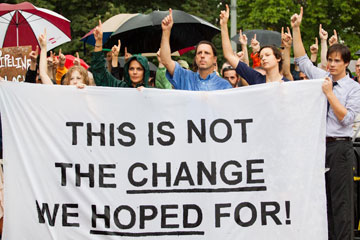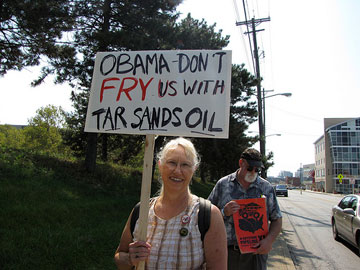
Protestor against Keystone XL Pipeline escorted away after arrest. Photo by: Josh Lopez/Tar Sands Action.
Climate and environmental activism in the US received a shot of enthusiasm this summer when it focused unwaveringly on the Keystone XL Pipeline. During a two week protest in front of the White House, 1,253 activists—from young students to elder scientists, from religious leaders to indigenous people—embraced civil disobedience for their cause and got themselves arrested. The protest, which attracted thousands of others who were not arrested, received widespread media coverage and made it so the Obama Administration can no rubber-stamp the pipeline without consequences.
Jamie Henn, spokesperson with Tar Sands Action, which organized the protests, and co-founder of climate organization 350.org, told mongabay.com that,
“the reason the Keystone XL pipeline has emerged as such a key fight is because it is on a specific time horizon, the Administration says it will issue a decision by the end of this year, and the decision whether or not to grant the permit rests solely on President Obama’s desk. This is a clear test for the President.”
The pipeline in question would bring oil from Canada’s tar sands down from Alberta to Texas, crossing six states. Protesters fear environmental damage, especially from possible oil spills; are frustrated with oil companies’ grip on US politics; and condemn the impacts of tar sands exploitation on the boreal forest and First Nations in Canada. And then there is climate change: Canada’s tar sands are significantly higher in greenhouse gas emissions and more energy- and water-intensive than more conventional sources of energy. Their exploitation has been seen by many climatologists as a symbol of humanity’s unwillingness to address the causes of a warming world, even decades after they have been identified.
 Protesters. Photo by: Ben Powless/Tar Sands Action. |
Still, approval of the Keystone XLK Pipeline long seemed assured by the Obama Administration: recently released emails under the Freedom of Information Act and new information about the review process has shown that the State Department has had a cozy relationship with the TransCanada, the company proposing the pipeline. A relationship, critics say, that has corrupted the entire review process.
“President Obama pledged to have ‘the most transparent government in history.’ This runs completely contrary to that promise,” Henn says.
Proponents of the pipeline argue it will bring jobs to the US and allow a secure oil supply from a friendly neighbor country.
But after years of disappointments on climate issues, protestors say that dropping the pipeline is a chance for the Obama Administration to prove it is still serious about combating climate change and freeing the US from its long dependence on fossil fuels. Many of the activists have pledged to essentially sit the next election out—at least in terms of volunteering and donations—if Obama approves the pipeline.
“Look, resisting the urge to squeeze out every drop of oil, cut every tree, mine every conflict diamond, etc. is going to be one of humanity’s greatest tests this century,” says Henn. “Making the right decision on the tar sands is a good place to start.”
In an October 2011 interview Jamie Henn discusses why the climate movement went after the Keystone XL Pipeline, recent scandals related to the pipeline’s government review process, the group’s embrace of the Occupy Wall Street movement, and what’s next in the battle against the pipeline, including encircling the White House.
INTERVIEW WITH JAMIE HENN
View Larger Map
The tar sands as seen from Google Earth near Fort McMurray, Alberta.
Mongabay: Why should Obama turn down the Keystone XL Pipeline?
Jamie Henn: The proposed Keystone XL pipeline would be another dirty needle feeding America’s fossil fuel addiction. The pipeline would carry tar sands oil from Alberta to the Gulf of Mexico. Along the way, it would cross the Ogallala Aquifer, risking an oil spill over one of our largest sources of fresh drinking water and the source of 30 percent of the irrigation water for America’s crops. Scientists say that fully developing the tar sands would mean essentially “game over” for the climate. Politically, the pipeline is also a bad call: it’s a hand out to Big Oil and people like the Koch Brothers who have consistently used their profits to corrupt our political system. The Keystone XL is not in the national interest of the United States and President Obama should deny the permit.
Mongabay: Why did the US climate movement decided to embrace civil disobedience?
 Activists prepare to greet US President Barack Obama at appearance in Columbus, Ohio. Photo courtesy of Tar Sands Action. |
Jamie Henn: Parts of the climate movement, especially those fighting mountain top removal in Appalachia, have been committed to the use of civil disobedience for a long time. What helped the rest in the movement to catch up, I think, was the realization that when it came to this pipeline the game was rigged. Just last week, the New York Times published a story that showed that the company the State Department hired to do the environmental review of the pipeline, Cardno Entrix, has as one of their top clients, TransCanada, the company looking to build the pipe. Emails gained through a Freedom of Information Act request show State Department officials cheering on TransCanada’s chief lobbyist, who just happens to be a former campaign manager for Hillary Clinton. Time and again, Big Oil’s dollars have outweighed the voices of scientists, economists, and everyday people. We realized we had to work in a different currency, namely our bodies and spirit. 1,253 people were arrested this August at the White House, many of them for the first time. I expect that we will see thousands more arrested over the months to come.
Mongabay: What have been the issues with the Obama administrations review of the Keystone Pipeline? Should these findings force the administration to begin anew?
Jamie Henn: The State Department should recuse itself from the Keystone XL decision and the whole permit process should be scrapped. The recent emails leaked from the State Department, combined with previous WikiLeaks revelations showing State Department officials advising Canadians on how best to “message” the tar sands, combined with the Department’s hiring of pipeline consulting firm Cardno Entrix to conduct their environmental review, show a clear and definite conflict of interest. President Obama pledged to have “the most transparent government in history.” This runs completely contrary to that promise. Denying the permit, right now, is the best step President Obama can take to protect the environment, clean up his administration, and show his supporters that he deserves their support in 2012.
Mongabay: What’s Tar Sands Action planning next on the pipeline?
 A young man, arrested on August 20th at the start of the Tar Sands Action, exits the courthouse after having spent 2 nights in jail. Photo by: Milan Ilnyckyj/Tar Sands Action. |
Jamie Henn: Right now, pipeline activists across the country are hosting rallies at every single one of President Obama’s public appearances, even as I write students in Pittsburgh and Miami are getting ready to take action. People are also visiting Obama for America campaign offices to say, “Listen, in 2008 I volunteered for Barack Obama. This year, I’m not going to volunteer a single hour or donate a single dollar until President Obama does the right thing and stops this pipeline.” And we’re building towards a big event: this November 6, one year before the election, we’re looking to bring over 5,000 people to Washington, DC to completely encircle the White House. We’ll be holding signs with President Obama’s own words, like, “Let’s be the generation that finally frees America from the tyranny of oil.” It will be a powerful reminder who put him in the White House and what he needs to do to stay there.
Mongabay: Why did climate activists choose to focus on the pipeline over the Obama administration’s approval of drilling in the Arctic, which is opening a new source of fossil fuels and, if a spill occurs, could be near-impossible to clean-up?
Jamie Henn: This is a multi-front battle and one that’s going to likely last our lifetimes. And there are a number of groups working specifically on drilling in the Arctic, Greenpeace in particular. On top of the environmental implications, the reason the Keystone XL pipeline has emerged as such a key fight is because it is on a specific time horizon, the Administration says it will issue a decision by the end of this year, and the decision whether or not to grant the permit rests solely on President Obama’s desk. This is a clear test for the President. No matter what he decides, this fight has lit a spark in the climate movement and I think will strengthen it for the many fights to come—not to mention all the good work we need to be doing to implement solutions!
Mongabay: Some have argued that Canada will simply ship the oil elsewhere if the US doesn’t use it. What’s your response?
Jamie Henn: Before the industry can ship the oil anywhere, they have to get it to port. Alberta’s Energy Minister Ron Liepert said himself that his biggest fear is getting stuck with “landlocked bitumen,” the type of the oil in the tar sands. The Keystone XL isn’t the only oil pipeline that’s facing massive opposition. Both of the big pipelines currently proposed to British Columbia are also stalled because of opposition from indigenous peoples and citizens on the coast who remember the Exxon Valdeez and don’t want giant oil tankers running through their waters. Look, resisting the urge to squeeze out every drop of oil, cut every tree, mine every conflict diamond, etc. is going to be one of humanity’s greatest tests this century. Making the right decision on the tar sands is a good place to start.
Mongabay: A lot of media has been portraying the issue as the ‘environment vs. jobs’. Is this an accurate depiction of the issue?
 A man is arrested in front of the White House. Photo by: Milan Ilnyckyj/Tar Sands Action. |
Jamie Henn: Yes and no. Let’s be honest: building this pipeline will create some jobs. In their initial filing to the State Department, TransCanada claimed it would create 5,000 jobs. Now they’re saying anywhere from 20,000 to 200,000 and for the most part the media has let them get away with it. The question is, at what cost? First, put the risks of an oil spill damaging the source of water for Nebraska’s $17 billion agricultural industry and the livelihoods of all the other ranchers and farmers along the route. Second, stack up the cost of our ongoing addiction to fossil fuel—you better believe that the profits from this pipeline will be used to lobby against the legislation we need to unleash a clean energy economy in this country. Third, stack up the impacts of the climate disruption that burning tar sands oil leads to. The list goes on and on. The media deals in cliches, so while it’s not surprising that this has become a “jobs vs. environment” debate, it’s disappointing that most outlets won’t cover the bigger picture.
Mongabay: A number of climate activists have participated in the Occupy Wall Street movement. What does this movement and climate activism have in common?
Jamie Henn: Last weekend, Tar Sands Action spokesperson and 350.org founder Bill McKibben gave a speech at Occupy Wall Street where he said, “The reason that it’s so great that we’re occupying Wall Street is because Wall Street has been occupying the atmosphere. That’s why we can never do anything about global warming. Exxon gets in the way. Goldman Sachs gets in the way. The whole fossil fuel industry gets in the way. The sky does not belong to Exxon. They cannot keep using it as a sewer into which to dump their carbon. If they do, we’ve got no future and nobody else on this planet has a future.” Occupy Wall Street is a great thing for the climate movement and a challenge for all of us to come together around common struggles.
Mongabay: After the decision is made on the pipeline, where does climate activism go next?
Jamie Henn: Well, it’s already gone global: over the last three years with 350.org we’ve organized some 15,000 climate demonstrations in nearly every country except North Korea. Now, I think we need to do more to go directly to the source of the problem. That will look like a number of things, first, continuing fights around the world to keep fossil fuel in the ground, and second, continuing to follow the money and expose the corporations and industries that stand in the way of progress. All the while, we need to keep up the good and heartening work of building community resilience, implementing climate solutions, and working with our neighbors to imagine a sustainable future. Look, it’s been said before, but we really are running out of time to avoid the worst impacts of climate change. If there was ever a time to escalate, to take risks, to do things we haven’t done before, that time is now. I think the months and years ahead will be very difficult, but very exciting.

High school students who oppose the Keystone XL Pipeline who recently met with Assistant Secretary of State Kerri-Ann Jones. Photo by: Josh Lopez/Tar Sands Action.

Man taken away by police. Photo by: Josh Lopez/Tar Sands Action.

High School student protests. Photo by: Josh Lopez/Tar Sands Action.

James Phillips, Ezekiel Perkins and Peter Roquemore ban together as the masses thin and fill the police wagons. Photo by: Josh Lopez/Tar Sands Action.

Young woman is placed in handcuffs and arrested in front of the White House. Photo by: Josh Lopez/Tar Sands Action.
Related articles
Keystone pipeline company hand-picked US government’s environmental assessor
(10/10/2011) A little over a month after 1,252 people were arrested in two weeks of civil action against the Keystone XL Pipeline, The New York Times has revealed that the Obama administration allowed a consulting firm with financial ties to the pipeline to conduct the project’s Environmental Impact Assessment (EIA). While it is not uncommon for government departments to ‘outsource’ EIAs, legal experts quoted in the piece expressed surprise that the State Department would select a firm so close to the company proposing the project.
Obama administration opens more of the Arctic to drilling
(10/05/2011) Nearly 500 Arctic oil and gas leases from the Bush administration have been restarted this week by the Obama administration. Known as Chukchi Lease 193, the various leases had been held up in court after environmental groups and indigenous groups challenged them, citing a significant lack of baseline information about the Chukchi Sea ecosystem. The Obama administration now says that many of the ecosystem gaps need not be filled, but Arctic indigenous and environmental groups disagree.
Fossil fuel subsidies going in the wrong direction?
(10/05/2011) In 2009, G20 nations committed to phasing out fossil fuel subsidies over the medium term, yet are further away today than they were two years ago from keeping the pledge. According to the International Energy Agency (IEA) fossil fuel subsidies rose by nearly $100 billion in the last year alone, from $312 billion in 2009 to $409 billion in 2010. The agency warned that subsidies could reach $660 billion by 2020 if governments don’t act on reform.
Over 100 arrested as tar sands civil disobedience spreads to Canada
(09/27/2011) After two weeks of sustained protesting at the US White House against the Keystone XL pipeline, with 1,252 people arrested, civil disobedience has now spread to Canada, home of the tar sands. Yesterday, around 500 people protested in Ottawa against Canada’s controversial tar sands; 117 were arrested as they purposefully crossed a barrier separating them from the House of Commons in an act of civil disobedience.
Activists worldwide push for leaving the fossil fuel age behind

(09/25/2011) On six continents, in over 75 percent of the world’s countries, people came out en masse yesterday to attend over 2,000 events to demonstrate the power of renewable energy to combat global climate change. As apart of the ‘Moving Planet’ campaign organized by 350.org, activists created a giant human-windmill in Paris, gave out bike lessons in Buenos Aires, practiced evacuation measure in the Pacific island of Tuvalu imperiled by rising sea levels, and marched in Cape Town for a strong agreement at the next UN climate meeting hosted in Durban, South Africa.
Climate test for Obama: 1,252 people arrested over notorious oil pipeline

(09/06/2011) Two weeks of climate disobedience at the White House ended over the weekend with 1,252 people arrested in total. Activists were protesting the controversial Keystone XL pipeline in an effort to pressure US President Barack Obama to turn down the project. If built the pipeline would bring oil from Alberta’s tar sands through six US states down to Texas refineries. While protestors fear pollution from potential spills, especially in the Ogallala Aquifer which supplies water to millions, the major fight behind the pipeline is climate change: Canada’s tar sands emit significantly more carbon than conventional sources of oil.